Sound Generation on a Car with and without Spoiler
$140.00 $70.00 Student Discount
- The problem numerically simulates Sound Generation (Acoustic) on Audi Car with and without Spoiler using ANSYS Fluent software.
- We design the 3-D model by the Design Modeler software.
- We Mesh the model by ICEM software.
- We use the Broadband Noise Sources model to define the Acoustic model of the present work.
- We aim to study changes in acoustic power level (dB) or sound pressure in the present work.
To Order Your Project or benefit from a CFD consultation, contact our experts via email (info@mr-cfd.com), online support tab, or WhatsApp at +44 7443 197273.
There are some Free Products to check our service quality.
If you want the training video in another language instead of English, ask it via info@mr-cfd.com after you buy the product.
Description
Sound Generation (Acoustic) on Audi Car with and without Spoiler, CFD Simulation Ansys Fluent Training
Sound Generation on Audi Car with and without Spoiler has been simulated in this project, and the simulation results have been investigated using ANSYS Fluent software. We perform this CFD project and investigate it by CFD analysis.
Acoustics is a science that deals with the study of mechanical waves in gases, liquids, and solids, including vibration, sound, ultrasound, and infrasound. It concerns production, control, transmission, reception, and sound effects.
The present model is designed in three dimensions using the Design Modeler software. This geometry has meshed in ICEM software.
Sound Generation Methodology
The problem simulates sound pressure waves around a car using Ansys Fluent software. Aeroacoustics is a branch of acoustic science that investigates the production of Noise.
In general, Noise can be generated by the movement of turbulent fluid or from collisions of aerodynamic forces with surfaces. Turbulent fluid motion is associated with pressure and density gradient, resulting in velocity gradient, and these changes have oscillating nature and are the source of sound waves.
Topics related to sound waves are essential in aerospace applications and fields Because the sound waves produced in aerospace devices such as airfoils are very high.
This project examines the sound waves generated around the body of a car. This project uses an acoustic model in Fluent software to simulate and analyze sound or acoustic waves. The Broadband Noise Sources model has also been used to define the acoustic model of the present work.
Definitive density is equivalent to air density, i.e., 1.225 kg / m3, sound speed is equivalent to sound speed in the air, i.e., 340 m / s, and the reference acoustic power is equal to 1e-12 pascal. In this model, an Audi car with and without a spoiler is designed, and the airflow moves towards this car with speed equal to 70 m/s.
This project has been carried out in two modes, with and without spoilers. Moreover, the SST k-omega model is used to solve turbulent fluid equations.
Sound Generation Conclusion
At the end of the solution process, two-dimensional contours related to pressure and velocity, as well as diagrams of changes in velocity and acoustic power level in both two states, are obtained.
The figures show the amount of change in acoustic power level (dB) or the amount of sound pressure in terms of location in the longitudinal direction. This location indicates a few meters before the location of the car body, then on the surface of the car body, and finally a few meters after the car body.
As can be seen in the plots, the sound wave generated due to the hit of the airflow to the car is reduced in the case of a car with a spoiler. The Acoustic power level in the case without a spoiler is about 95 dB and in the case with a spoiler is about 70 dB.
Although in the far-field part of the geometry behind the car, in the case of a car with a spoiler is more than the other case.
A car without Spoiler:
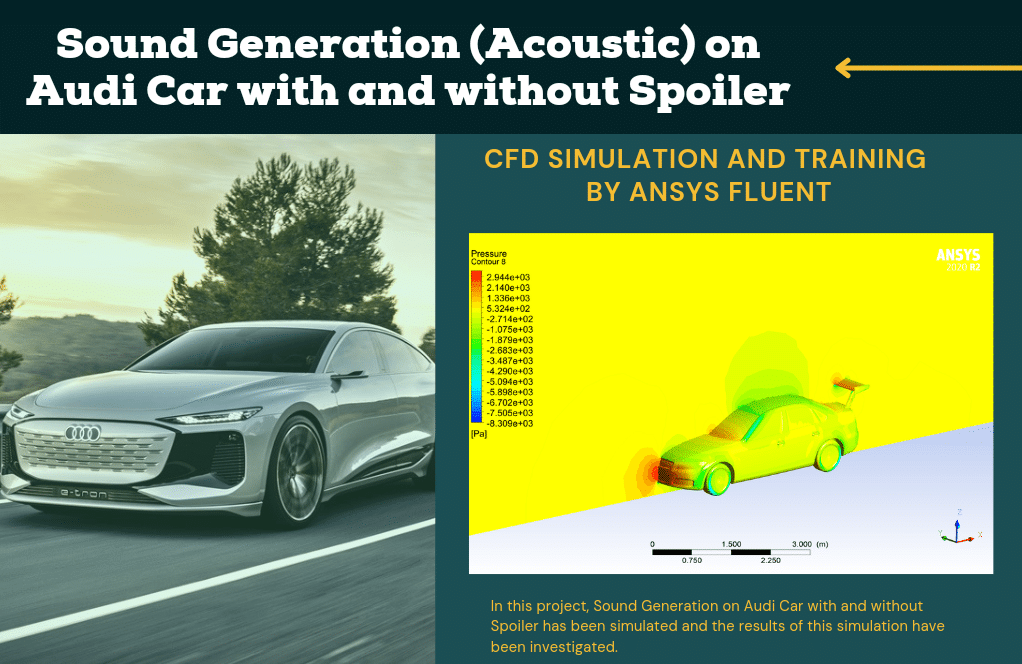
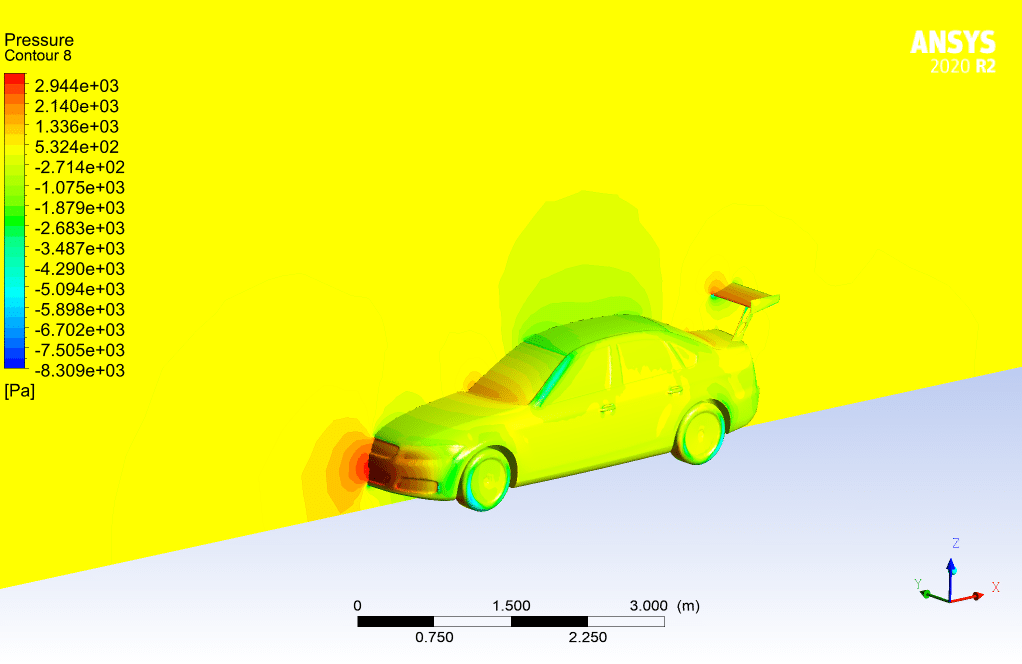
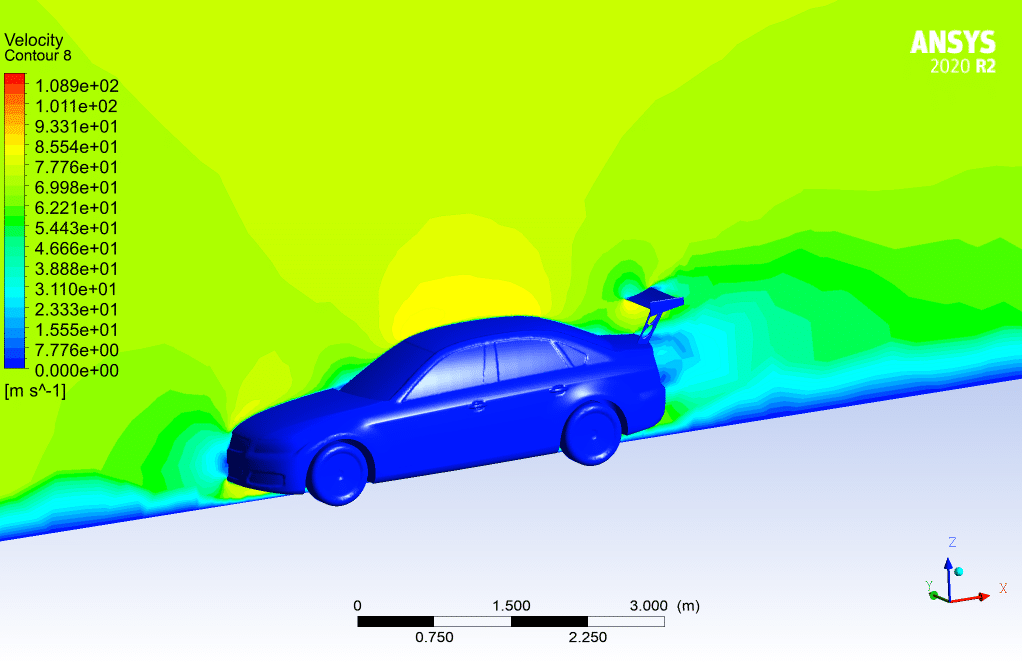
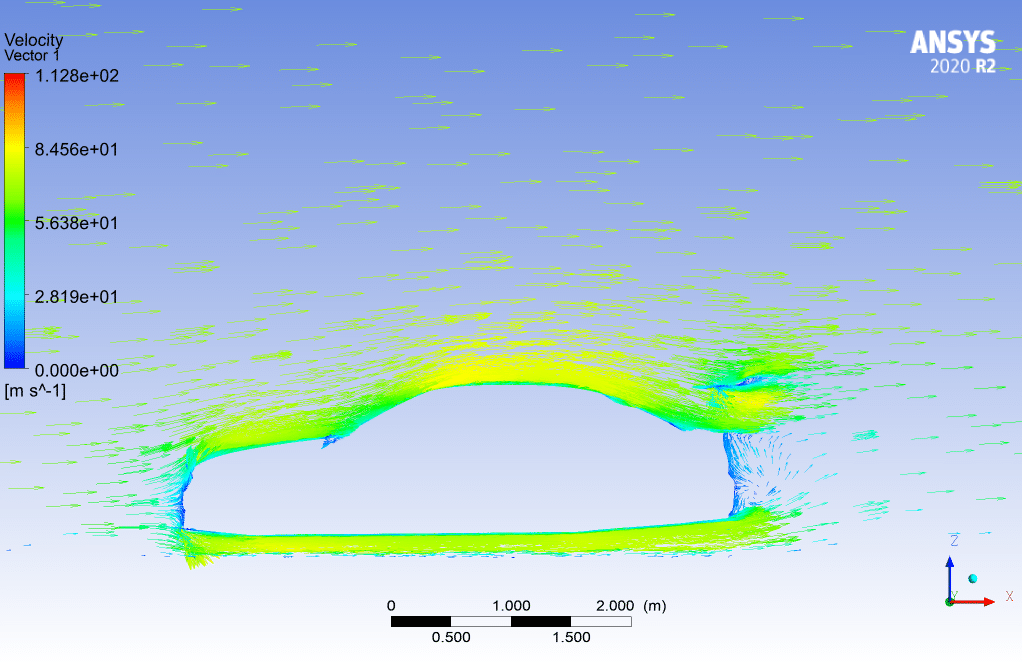
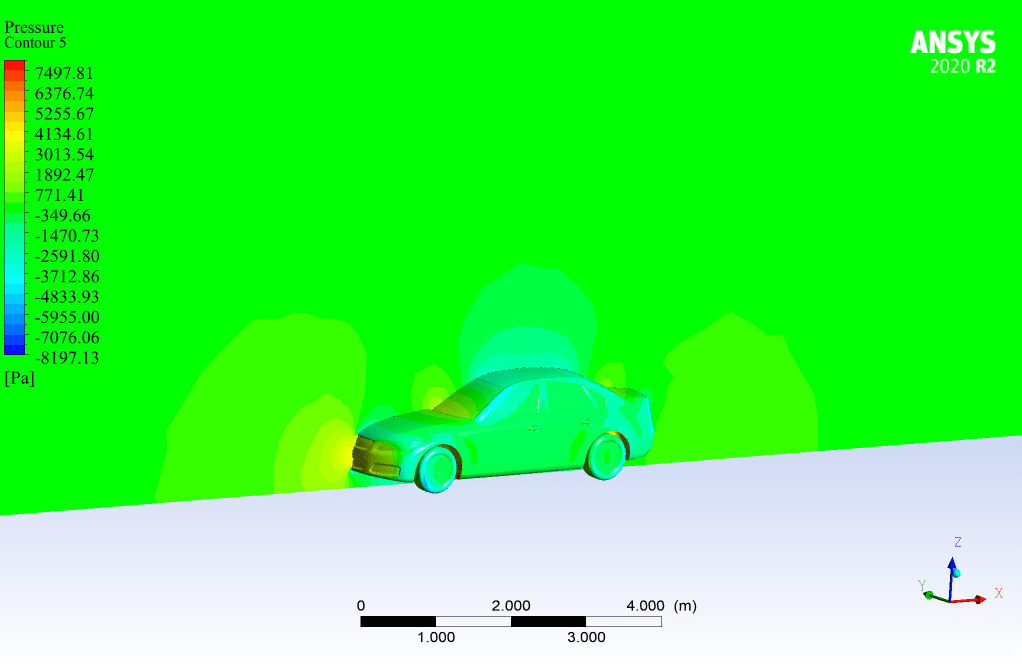
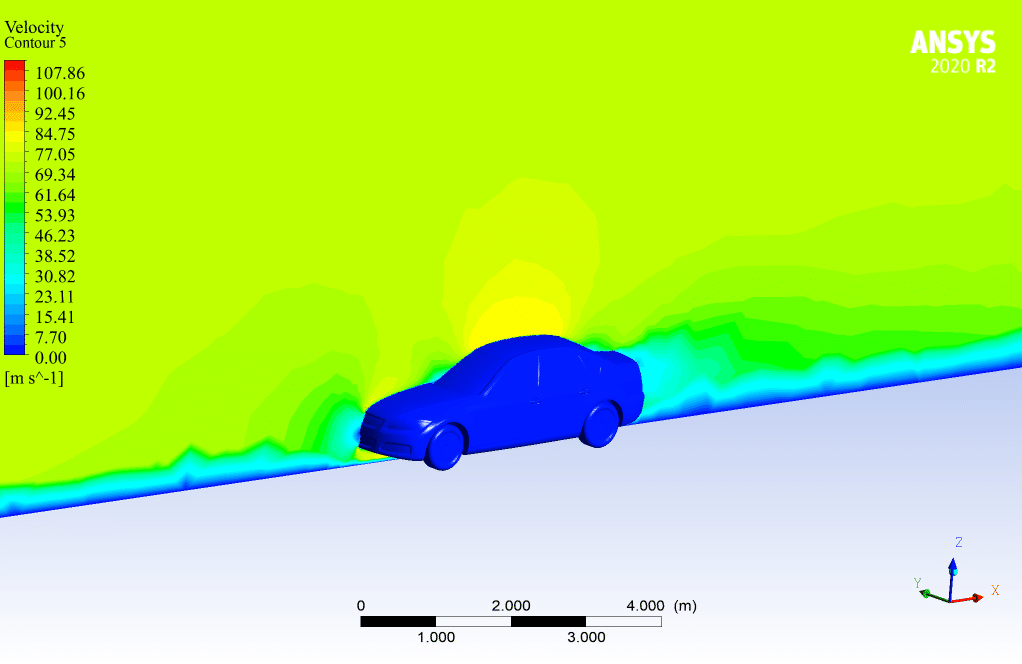
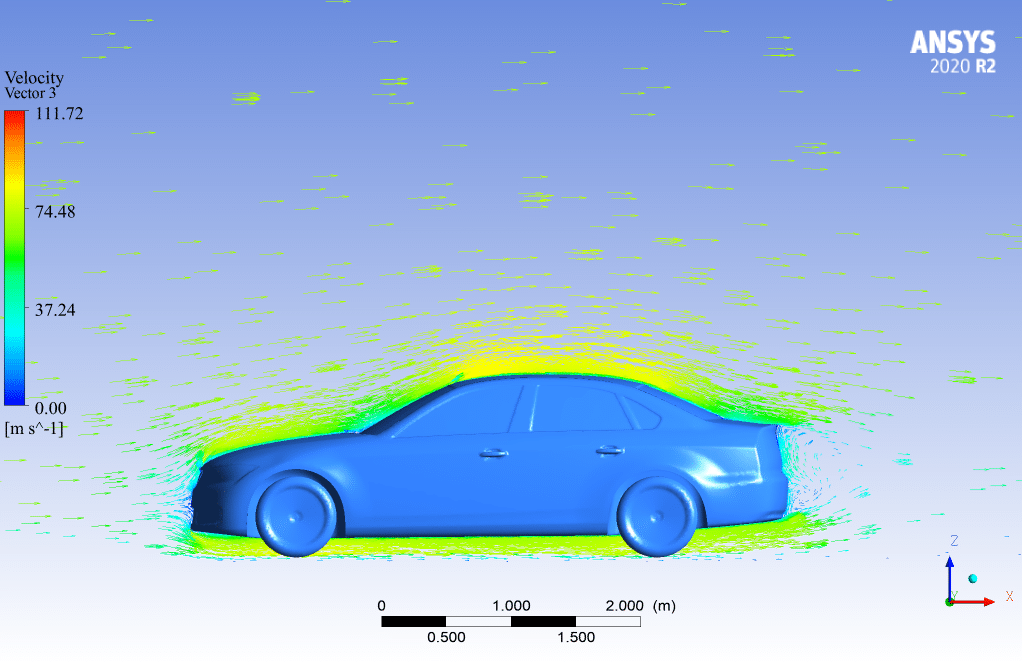

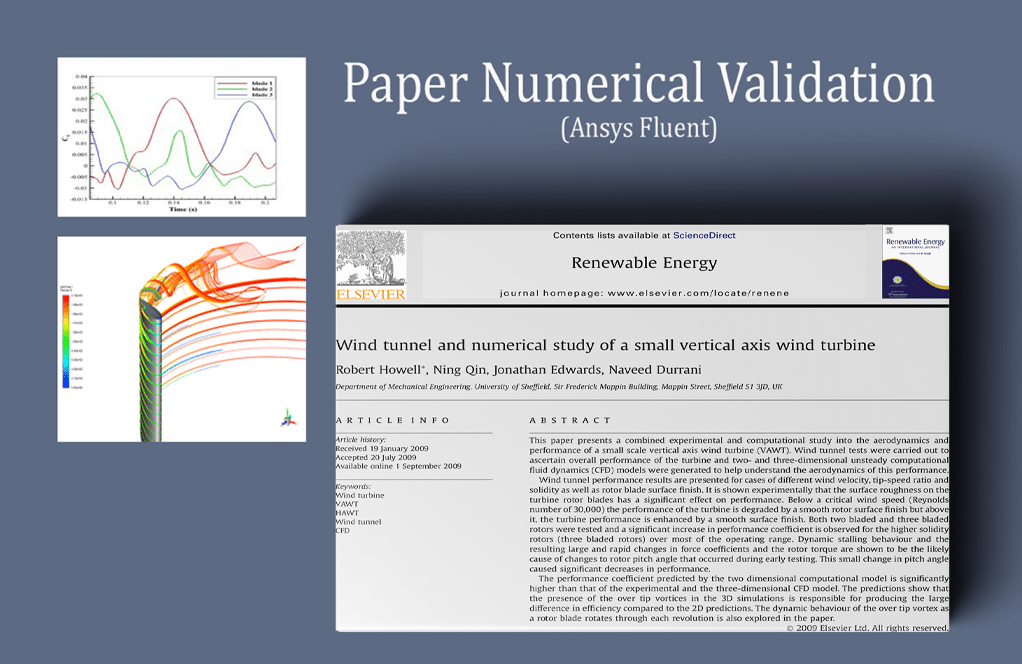
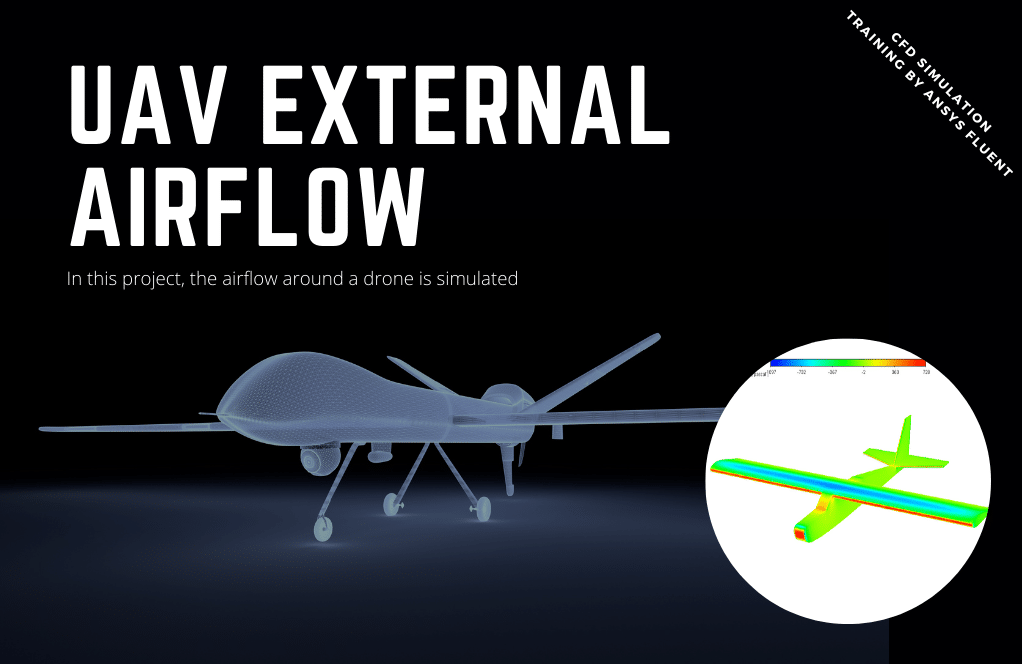

Nathaniel Johnson –
The comparison of sound pressure levels with and without a spoiler is really intriguing. However, what causes the significant reduction in sound pressure when a spoiler is included? Is it purely due to the change in airflow, or are other factors at play?
MR CFD Support –
The significant reduction in sound pressure when a spoiler is included is generally attributed to changes in airflow patterns. Spoilers are aerodynamic features that alter the way air moves over the vehicle body. This modification can reduce turbulence and vortex formation, which are key sources of noise. Additionally, the redirection of airflow can lead to less interaction between high-speed air and car components, thereby reducing acoustic power levels. Other factors, such as a change in the vehicle body’s resonance characteristics with spoiler addition, may also contribute to sound reduction.
Nicola Homenick –
I was particularly impressed with how the simulation illustrated the difference in sound generation with and without the spoiler. It was fascinating to see the reduction in noise levels when a spoiler is installed. Do you have any information on the specific impact that different types of spoilers have on sound reduction?
MR CFD Support –
Thank you for your positive feedback! We haven’t provided specific comparisons between different types of spoilers in this simulation. However, the impact on noise reduction can vary based on spoiler design, area, and how it affects the airflow around the car. Such detailed analysis can be conducted through separate simulations for each spoiler type, examining the effects on acoustic power levels and sound pressure distribution.
Ruben Friesen –
I am impressed with the realistic expectations set in the simulation of sound generation on a car with and without a spoiler. It seems like a valuable resource for understanding the acoustic impact of design changes in automotive engineering. I appreciate the detailed methodology and the conclusions highlighting the decrease in acoustic power level when a spoiler is present. Great work!
MR CFD Support –
Thank you for your positive feedback! We’re thrilled to know that our simulation for sound generation met your expectations and offered valuable insights. It’s always rewarding to hear that our product is helpful for understanding the complex dynamics of automotive engineering. If there’s anything more you wish to explore or need further clarification, don’t hesitate to reach out!
Holden Christiansen –
Your explanation on the SST k-omega model is great. Curious to understand more about why this specific turbulence model was chosen over others for this acoustic simulation.
MR CFD Support –
The SST k-omega model provides an accurate boundary layer prediction under adverse pressure gradients and free-stream turbulence. It’s useful for capturing the characteristically unsteady flow phenomena connected with noise generation in aerodynamic applications. This model’s blend of k-omega model in the near-wall region and k-epsilon model in the far field strikes a good balance for the complex aerodynamics around a car, especially considering the impact of a spoiler on flow separation and acoustic characteristics.
Dr. Lexus Berge DVM –
I was amazed to see that the spoiler significantly reduced the sound generation on the Audi car in the simulations. What contributes to the decrease of the acoustic power level when a spoiler is added to the car?
MR CFD Support –
The addition of a spoiler changes the aerodynamics of the car. It does so by reducing lift and drag, and as a result, alters airflow patterns around the car’s body. This alteration in airflow can minimize the size and energy of turbulent wake areas behind the car, where much of the aerodynamically generated noise originates. Consequently, less turbulence and cleaner airflows lead to a reduction in the acoustic power level, as observed in the CFD simulations.
Jameson Jacobi –
The comparison of acoustic power level results between a car with a spoiler and without is fascinating. Did the added spoiler primarily reduce noise levels around the passenger cabin area, or was the effect observed more significantly in other areas around the vehicle?
MR CFD Support –
Thank you for your interest in the acoustic analysis of the car with and without a spoiler using CFD simulation. The addition of a spoiler generally impacts the airflow patterns around the car, which can affect the noise levels in various areas. As observed in the results mentioned in the review, the spoiler reduces the acoustic power level from about 95 dB to around 70 dB, which indicates that the spoiler has a noise reduction effect. The presence of a spoiler can streamline the airflow around the car, especially at the rear, thus reducing turbulence and associated noise. Although where precisely these effects are most noticeable wasn’t specified, typically, such aerodynamic modifications can lead to reduced noise levels in the cabin and improved acoustics around the rear of the car. Computational Fluid Dynamics (CFD) allows for detailed analysis of these areas, providing information on how sound pressure levels differ before and after the application of a spoiler.
Vivienne O’Kon –
What are the advantages of using the SST k-omega model for turbulent flow equations in this kind of acoustic simulation?
MR CFD Support –
The SST k-omega model is advantageous for this acoustic simulation as it offers a balance between accurately predicting the boundary layer behavior and handling adverse pressure gradients. It’s particularly effective for capturing the flow features that affect the noise generation mechanisms around complex geometries like cars with and without spoilers.
Garrett DuBuque II –
What practical applications would benefit from the knowledge of the spoiler’s acoustic effects on a car as studied in this simulation?
MR CFD Support –
The knowledge obtained from this simulation can be very beneficial in the automotive industry, especially for the design and engineering of high-performance vehicles where aerodynamics and noise reduction are crucial. This includes race cars, sports cars, and luxury vehicles where drivers value both performance and comfort. Additionally, it might be important for urban planning and noise pollution management around highways and in residential areas.
Euna Goyette –
What a fantastic resource! I see a reduction in noise levels when using a spoiler; this kind of real-world application brings the theory to life. The 25dB decrement is particularly noteworthy!
MR CFD Support –
Thank you for your positive feedback! We’re thrilled to hear that you find the comparison between scenarios with and without a spoiler enlightening. The real-world applicability of our simulated scenarios is something we constantly strive for. It is gratifying to know that the detailed analysis, such as the 25dB noise reduction you mentioned, is both impactful and appreciated.
Elsa Lueilwitz –
I’m curious—how does the presence or absence of a spoiler affect the simulation buzz?
MR CFD Support –
The presence or absence of a spoiler significantly changes the aerodynamic flow around the car, which in turn affects the sound generation. The spoiler can influence the separation and reattachment of the airflow, affecting the pressure and velocity gradients and thus the oscillation characteristics that generate sound. As per the conclusion, the simulation demonstrates a decrease in the acoustic power level (which correlates with the perceived loudness of sound) from 95 dB without a spoiler to about 70 dB with a spoiler.
Saige Heller –
What makes the sound pressure decrease when a spoiler is added to the car, based on the simulation?
MR CFD Support –
The spoiler changes the way air flows around the body of the car, reducing aerodynamic lift and drag in certain areas. This streamlined flow minimizes air vortices and turbulence that are major contributors to sound generation. As a result, the efficient passage of air mitigates the pressure and density gradients that give rise to noise, leading to a quieter region behind the car where the spoiler’s influence is the greatest.
Mrs. Rhoda Johns –
Fantastic training on acoustics using ANSYS Fluent! It’s fascinating to see the difference a spoiler makes in sound generation on a car. Could you please specify how the acoustic model settings affect the accuracy of the simulated sound generation compared to real-life experimental data?
MR CFD Support –
Glad to know that you’ve found the training interesting! The acoustic model settings in ANSYS Fluent, particularly the Broadband Noise Sources model, are key for capturing the sound generation mechanisms accurately. The model takes into account the pressure and density fluctuations caused by turbulent flows which are the sources for sound waves. Finding correlation with real-life data requires fine-tuning the numerical settings, ensuring mesh independence, and validating the model against experimental benchmarks. Employing such detailed acoustic analysis helps to make sure the predictions align closely with physical tests. Thank you for your inquiry!
Cade Hills –
What specific aspects of spoiler design contribute to the reduced acoustic power level as observed in the simulation outcomes?
MR CFD Support –
The specific aspects of the spoiler design that contribute to the reduced acoustic power level include its aerodynamic shape which streamlines airflow over the car, minimizing turbulence and the associated noise. By managing the airflow patterns, the spoiler reduces the formation of vortices and the resulting pressure fluctuations that act as sound generation sources.
Dr. Lorenza Johnson II –
Could you clarify how the presence of a spoiler affects the acoustic power level differences in both near-field and far-field regions?
MR CFD Support –
In the presence of a spoiler, the airflow around the car is more controlled, which reduces turbulence and consequently sound generation in the local area close to the car (near-field). Thus, the acoustic power level is generally lower near the car with a spoiler compared to the one without. However, this controlled flow can also lead to directed airflow in the wake of the car, which might increase acoustic power levels in the far-field area as the wake interacts more coherently with this spoiler structure.
Dr. Brain Rohan –
I’m really impressed with the sound generation analysis on the Audi with and without a spoiler! The readout of reduction from 95 dB to 70 dB with a spoiler is fascinating. Have you noticed whether there’s a significant impact on fuel efficiency or overall performance as well when the spoiler is added, considering the implicit aerodynamic changes?
MR CFD Support –
Thank you for your compliments on the CFD simulation project on sound generation! We’re also glad to see your interest in the subtler effects of installing a spoiler. Indeed, adding a spoiler can affect the aerodynamic performance, which can, in turn, influence fuel efficiency and even handling characteristics of the car depending on speed and driving conditions. However, these aspects are beyond the scope of the acoustic analysis provided and would require a dedicated aerodynamic CFD study to provide precise data on fuel efficiency and performance changes.
Leo Witting –
Was there a significant difference in the sound generation between the car with a spoiler and the car without a spoiler?
MR CFD Support –
Yes, based on the simulation results, there was a noticeable difference in sound generation. The acoustic power level for the car without a spoiler was about 95 dB, while for the car with a spoiler, it was approximately 70 dB. It indicates that there was a reduction in the sound pressure level when the car had a spoiler attached, though the far-field noise behind the car increased with the spoiler.
Maiya Beer –
Can you distinguish the difference in sound generation more clearly between the car with a spoiler and without? How does the spoiler affect the aerodynamics that might lead to a change in acoustics?
MR CFD Support –
The spoiler on a car alters the airflow patterns around the vehicle, which can have a significant impact on sound generation. In the case of the car with a spoiler, the airflow is redirected more smoothly over the car, which can reduce the levels of turbulent wake behind the vehicle. This smoother airflow reduces the generation of vortices and turbulence intensity around and behind the car—key contributors to noise production. As a result, the models show a decrease in acoustic power level when a spoiler is present, with about a 25 dB reduction according to the provided figures. In aerodynamics, the goal of a spoiler is often to reduce drag and lift; however, this modification also has beneficial effects on acoustics by reducing the sound pressure levels generated.
Sedrick Carter –
The review seems really positive! Just wondering if the airflow characteristics differ significantly between the two spoiler configurations beyond their acoustic effects? Also, are there visualizations available that show the flow patterns around the car with and without the spoiler?
MR CFD Support –
Yes, the presence of the spoiler alters the aerodynamics of the car, which can affect the airflow characteristics and patterns around the car. Visualizations in form of streamline and pressure contour plots are typically employed in CFD analyses to provide insight into the flow patterns. These visualizations helps us to better understand the impact of the spoiler on the aerodynamic behavior of the vehicle. You can usually find them in the final presentation of the simulation results.